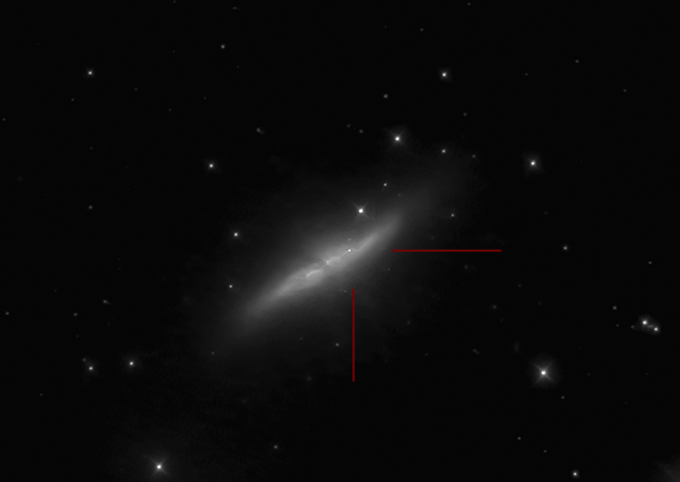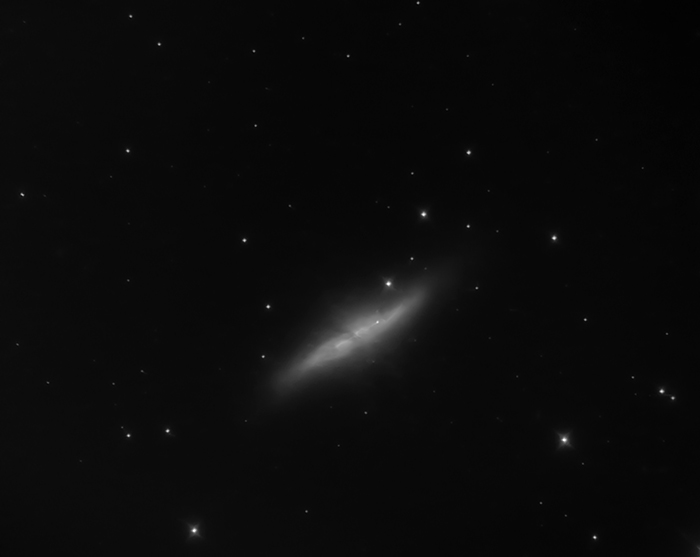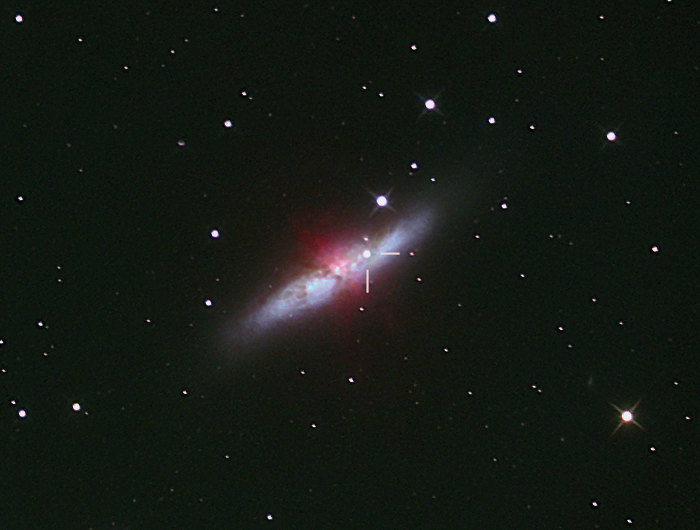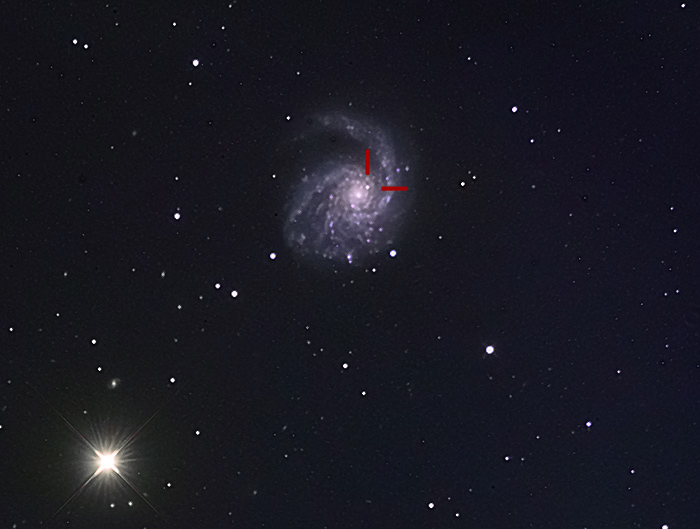01/23/2014. Time out for a supernova in M82. I'm told every telescope that can see it has turned to M82, so who am I to point mine elsewhere? Never mind that the sky was completely overcast when I went to bed. I mean, nothing came through. So I was shooting blind. Let me tell you how I got the photo below.

M82
Supernova 2014J marked
21x150s (52m30s total) L
2:30AM - 3:25AM, 1/24/2014
Unguided.

M82
41x150s (1h24m30s total) L
2:30AM - 4:05AM, 1/24/2014
Unguided.
I put the CCD behind the Ritchey and waited until I could command a slew to M82 that would not cause the camera to collide with the pier. Then I read a book (fittingly enough about the history of neutrino research -- I'd just come to the chapter on exploding stars) while the computer displayed a blank screen for two hours. I was waiting for a guide star (or any star) to appear. None did. The ClearSkyClock said the sky would clear by 2; it's often a little pessimistic, but at 2:00AM I still had a perfectly blank screen. So I went to bed, but I told the camera to start shooting unguided 150 second exposures. 100 of them. That would take until well into morning twilight. In the morning, I'd see if the sky had cleared and if the aim, focus, and tracking were decent.
Less than half an hour after I gave up and went to bed, the sky cleared. Pointing was excellent! Focus was solid. Tracking was tolerable. M82 was almost centered. There was some drift, but most of it could be processed out. This isn't bad; I'll do better.
SN2014J is the youngest supernova I've ever photographed (on the order of 48 hours since discovery). At discovery, it was said to match up best with a Type Ia SN 14 days prior to maximum, so it should have lots of room to brighten.
1/24/2014. And now in color. The supernova is 0.3 magnitudes brighter than it was 22 hours ago. The sky is clear, so I could pick out a bright guide star and leave the telescope to its business without worrying about the target wandering off the chip as the night wore on. I messed around some with M33 and with IC410 ("the tadpoles") first, but as soon as M82 cleared Bird Feeder Tree, I sent the telescope over its way. Still not as sharp as I'd like, but getting there.

SN 2014J in M82
Luminance: 26x105s L (1h5m)
Color: 2x1800s Ha (1h), 6x150s GB (30m)
1/29/2014. When it rains? The supernova in M82 is joined in the winter sky by a supernova in M99. I took images of NGC 660 to start the evening and finish a photo begun last fall, but that can wait a little longer. I shot M82 to check on the progress of SN2014J and then caught M99 rising through the gap over the 19th fairway and had the telescope follow it the rest of the night.

M82 with SN 2014J
5x150s L (12m30s), 7x150s RGB (45m total)
In the calibrated L frames, Maxim's photometry shows SN 2014J to be ~10.6 tonight, almost half a magnitude brighter than in my earliest images. M82 is a small galaxy (about a quarter the size of the Milky Way) about 11 million light-years away so the supernova is conspicuous. M99, by contrast, is a huge galaxy (about eight times the size of the Milky Way) about 50 million light-years away. So not only is its supernova fainter because of distance it is also less prominent in its huge host. On the other hand, M82's supernova may be obscured by a lot of gas and dust in the plane of its edge-on galaxy while M99's is probably not obscured by much of anything in its face-on spiral.
 M99 with SN 2014L
M99 with SN 2014L
44x150sL (1hr50m), 11x150s RGB (1h 22m 30s total)
Told you it would be harder to pick out. Photometry with Maxim (using Guide for comparison stars), says it's around 15.3, or about 75x fainter than M82's supernova. Here's a cheat sheet cropped from the image above and marked:

M99 with SN 2014L
44x150s L (1hr50m), 11x150s RGB (1h 22m 30s total)
Psst, wanna get a little dizzy? Just above the bright foreground star at lower left is a tiny spiral galaxy. That's LEDA 165065, a galaxy about the same size as the Milky Way but 500 million light-years in the distance.
(And I should mention that "bright" is a relative term; the "bright" star is magnitude 6.5, just at the limit of visibility to the naked eye in a very dark, very clear sky.)
Better images of both SN's are on the next Slowblog page.
Except where noted, deep-sky photos are made with an SBIG ST2000XM CCD behind a 10-inch Astro-Tech Ritchey-Chretien carried on an Astro-Physics Mach1GTO. The CCD is equipped with Baader LRGB and 7nm H-a filters. The internal guide chip of the CCD most often keeps the OTA pointed in the right direction (I'll let you know when a Meade DSI and a separate OAG or guidescope takes its place). Camera control and guiding are handled by Maxim DL 5.12. The stock focuser on the AT10RC has been augmented with Robofocus 3.0.9 using adapters turned on the lathe downstairs. Maxim performs image calibration, alignment, and stacking; Photoshop CS4 and FocusMagic 3.0.2 take it from there. Gradient Xterminator by Russell Croman and Astronomy Tools by Noel Carboni see their share of work, too. Beginning in May 2013, PixInsight has taken over some of the heavy lifting for transfer function modification and deconvolution.
:: top ::